2000 FORD TAURUS octane
[x] Cancel search: octanePage 10 of 232

3. The fuel cap may not have been properly installed and securely
tightened.
These temporary malfunctions can be corrected by filling the fuel tank
with high quality fuel of the recommended octane and/or properly
installing and securely tightening the gas cap. After three driving cycles
without these or any other temporary malfunctions present, the
light should turn off. (A driving cycle consists of a cold engine
startup followed by mixed city/highway driving.) No additional vehicle
service is required.
If the
light remains on, have your vehicle serviced at the first
available opportunity.
Light is blinking:
Engine misfire is occurring which could damage your catalytic converter.
You should drive in a moderate fashion (avoid heavy acceleration and
deceleration) and have your vehicle serviced at the first available
opportunity.
Under engine misfire conditions, excessive exhaust temperatures
could damage the catalytic converter, the fuel system, interior
floor coverings or other vehicle components, possibly causing a fire.
Low fuel
Illuminates as an early reminder of a
low fuel condition indicated on the
fuel gauge (refer toFuel gaugein
this chapter for more information).
When refueling, after the light
comes on, the amount of fuel that is added will be less than the
advertised capacity since there is fuel still in the tank. The ignition must
be in the ON position for this lamp to illuminate. The lamp will also
illuminate for several seconds after the ignition is turned to the ON
position regardless of the fuel level to ensure your bulb is working.
Low coolant (if equipped)
This lamp will illuminate when the
engine coolant inside the reservoir is
low. This lamp will come on when
the ignition is first turned on, but
then should turn off. If the lamp
LOW
COOLANT
Instrumentation
10
Page 180 of 232
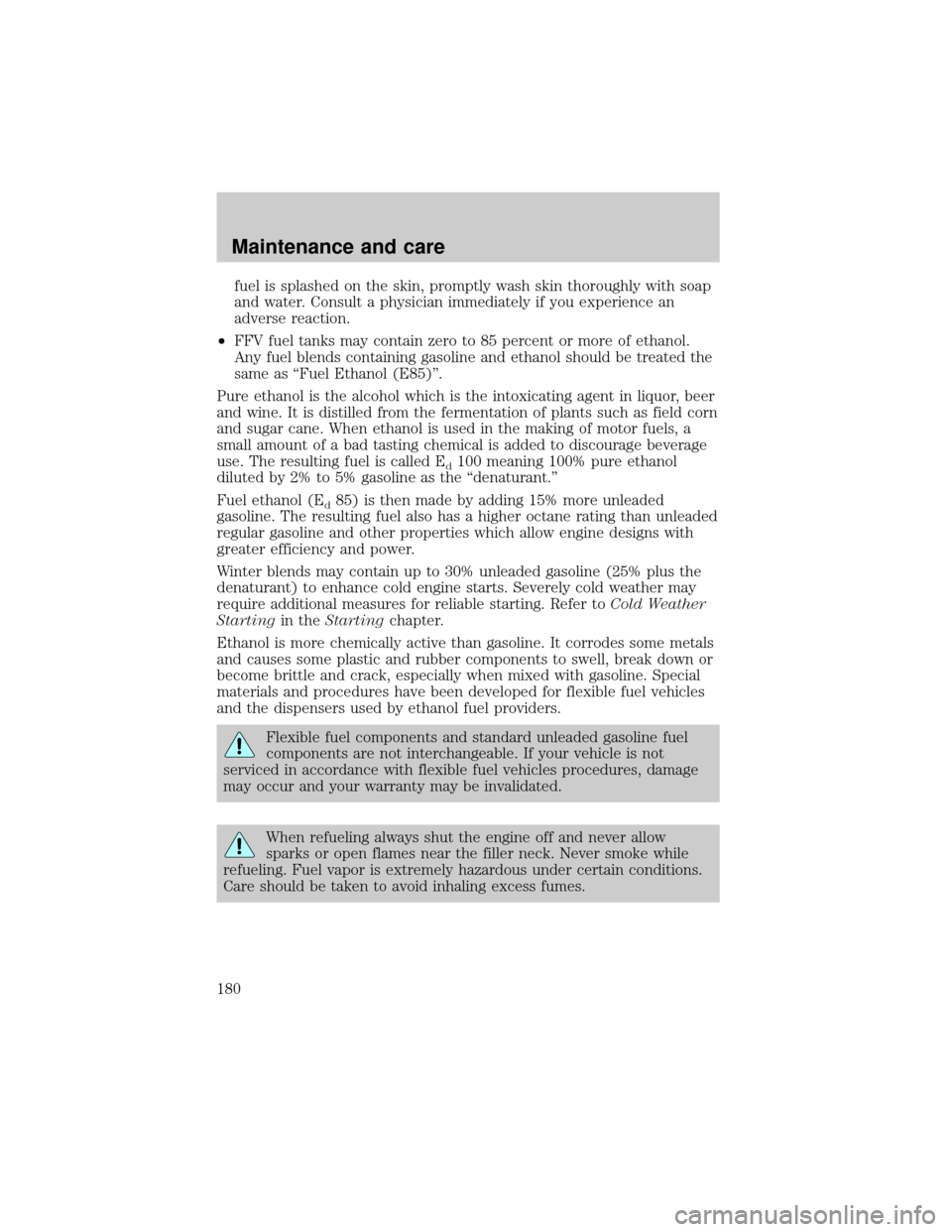
fuel is splashed on the skin, promptly wash skin thoroughly with soap
and water. Consult a physician immediately if you experience an
adverse reaction.
²FFV fuel tanks may contain zero to 85 percent or more of ethanol.
Any fuel blends containing gasoline and ethanol should be treated the
same as ªFuel Ethanol (E85)º.
Pure ethanol is the alcohol which is the intoxicating agent in liquor, beer
and wine. It is distilled from the fermentation of plants such as field corn
and sugar cane. When ethanol is used in the making of motor fuels, a
small amount of a bad tasting chemical is added to discourage beverage
use. The resulting fuel is called E
d100 meaning 100% pure ethanol
diluted by 2% to 5% gasoline as the ªdenaturant.º
Fuel ethanol (E
d85) is then made by adding 15% more unleaded
gasoline. The resulting fuel also has a higher octane rating than unleaded
regular gasoline and other properties which allow engine designs with
greater efficiency and power.
Winter blends may contain up to 30% unleaded gasoline (25% plus the
denaturant) to enhance cold engine starts. Severely cold weather may
require additional measures for reliable starting. Refer toCold Weather
Startingin theStartingchapter.
Ethanol is more chemically active than gasoline. It corrodes some metals
and causes some plastic and rubber components to swell, break down or
become brittle and crack, especially when mixed with gasoline. Special
materials and procedures have been developed for flexible fuel vehicles
and the dispensers used by ethanol fuel providers.
Flexible fuel components and standard unleaded gasoline fuel
components are not interchangeable. If your vehicle is not
serviced in accordance with flexible fuel vehicles procedures, damage
may occur and your warranty may be invalidated.
When refueling always shut the engine off and never allow
sparks or open flames near the filler neck. Never smoke while
refueling. Fuel vapor is extremely hazardous under certain conditions.
Care should be taken to avoid inhaling excess fumes.
Maintenance and care
180
Page 182 of 232
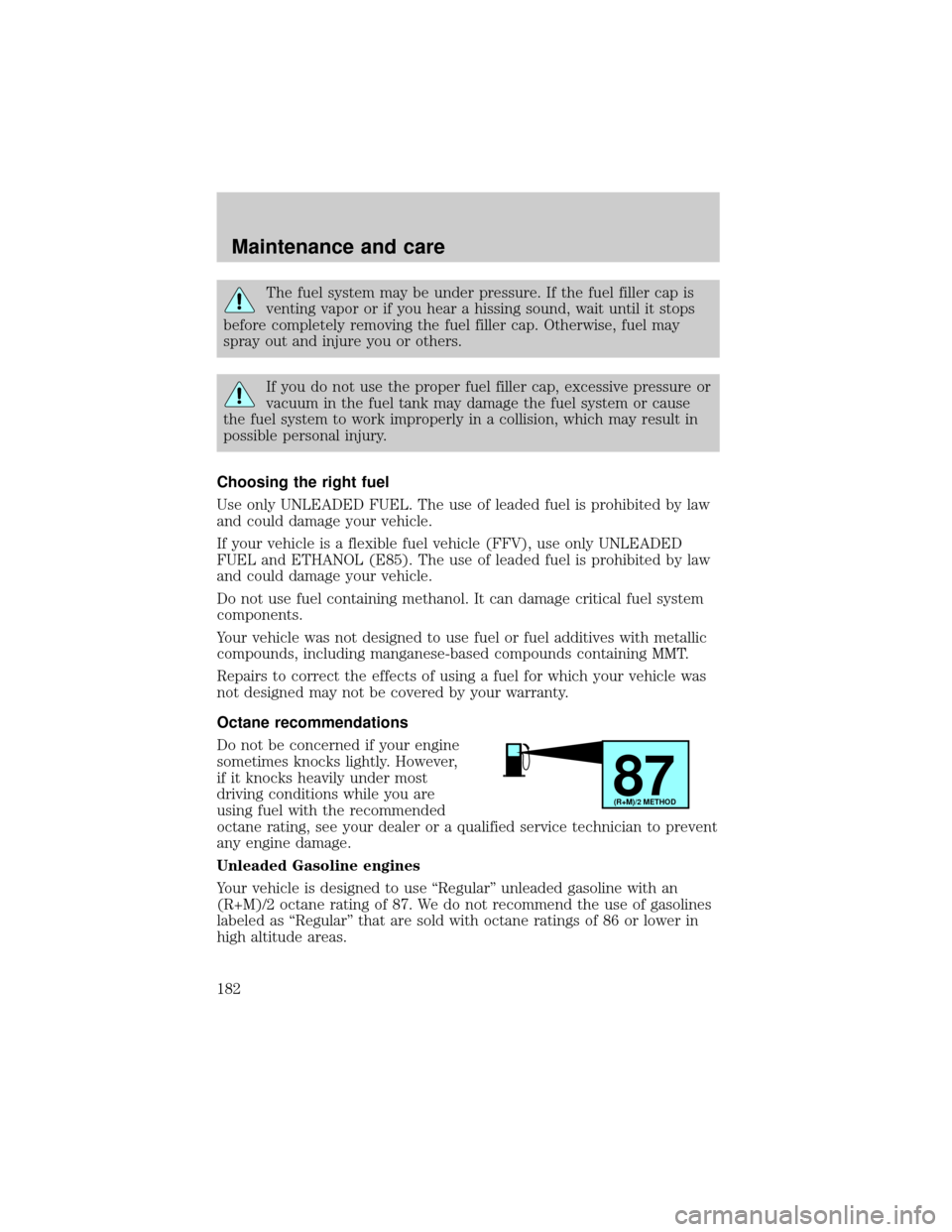
The fuel system may be under pressure. If the fuel filler cap is
venting vapor or if you hear a hissing sound, wait until it stops
before completely removing the fuel filler cap. Otherwise, fuel may
spray out and injure you or others.
If you do not use the proper fuel filler cap, excessive pressure or
vacuum in the fuel tank may damage the fuel system or cause
the fuel system to work improperly in a collision, which may result in
possible personal injury.
Choosing the right fuel
Use only UNLEADED FUEL. The use of leaded fuel is prohibited by law
and could damage your vehicle.
If your vehicle is a flexible fuel vehicle (FFV), use only UNLEADED
FUEL and ETHANOL (E85). The use of leaded fuel is prohibited by law
and could damage your vehicle.
Do not use fuel containing methanol. It can damage critical fuel system
components.
Your vehicle was not designed to use fuel or fuel additives with metallic
compounds, including manganese-based compounds containing MMT.
Repairs to correct the effects of using a fuel for which your vehicle was
not designed may not be covered by your warranty.
Octane recommendations
Do not be concerned if your engine
sometimes knocks lightly. However,
if it knocks heavily under most
driving conditions while you are
using fuel with the recommended
octane rating, see your dealer or a qualified service technician to prevent
any engine damage.
Unleaded Gasoline engines
Your vehicle is designed to use ªRegularº unleaded gasoline with an
(R+M)/2 octane rating of 87. We do not recommend the use of gasolines
labeled as ªRegularº that are sold with octane ratings of 86 or lower in
high altitude areas.
87(R+M)/2 METHOD
Maintenance and care
182
Page 183 of 232
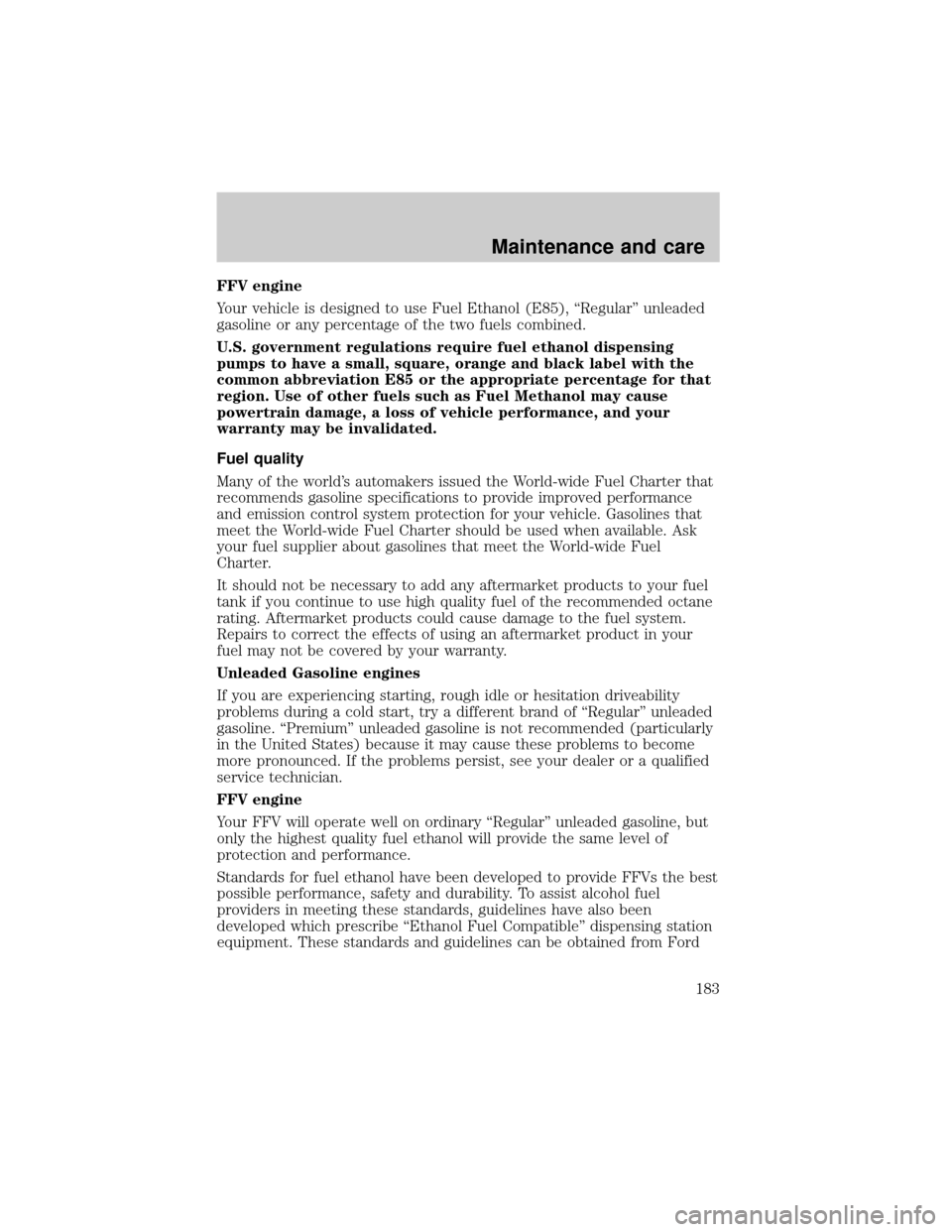
FFV engine
Your vehicle is designed to use Fuel Ethanol (E85), ªRegularº unleaded
gasoline or any percentage of the two fuels combined.
U.S. government regulations require fuel ethanol dispensing
pumps to have a small, square, orange and black label with the
common abbreviation E85 or the appropriate percentage for that
region. Use of other fuels such as Fuel Methanol may cause
powertrain damage, a loss of vehicle performance, and your
warranty may be invalidated.
Fuel quality
Many of the world's automakers issued the World-wide Fuel Charter that
recommends gasoline specifications to provide improved performance
and emission control system protection for your vehicle. Gasolines that
meet the World-wide Fuel Charter should be used when available. Ask
your fuel supplier about gasolines that meet the World-wide Fuel
Charter.
It should not be necessary to add any aftermarket products to your fuel
tank if you continue to use high quality fuel of the recommended octane
rating. Aftermarket products could cause damage to the fuel system.
Repairs to correct the effects of using an aftermarket product in your
fuel may not be covered by your warranty.
Unleaded Gasoline engines
If you are experiencing starting, rough idle or hesitation driveability
problems during a cold start, try a different brand of ªRegularº unleaded
gasoline. ªPremiumº unleaded gasoline is not recommended (particularly
in the United States) because it may cause these problems to become
more pronounced. If the problems persist, see your dealer or a qualified
service technician.
FFV engine
Your FFV will operate well on ordinary ªRegularº unleaded gasoline, but
only the highest quality fuel ethanol will provide the same level of
protection and performance.
Standards for fuel ethanol have been developed to provide FFVs the best
possible performance, safety and durability. To assist alcohol fuel
providers in meeting these standards, guidelines have also been
developed which prescribe ªEthanol Fuel Compatibleº dispensing station
equipment. These standards and guidelines can be obtained from Ford
Maintenance and care
183
Page 185 of 232
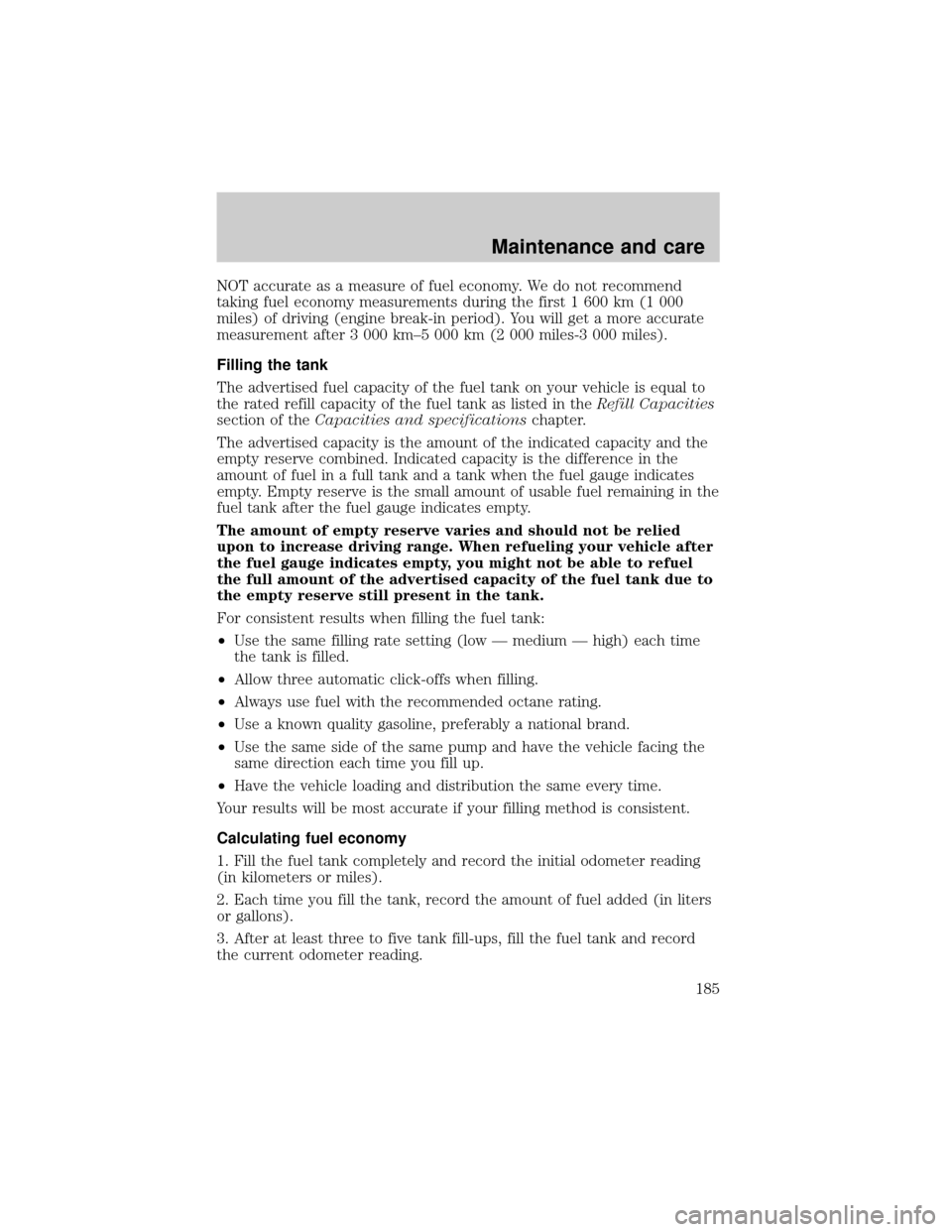
NOT accurate as a measure of fuel economy. We do not recommend
taking fuel economy measurements during the first 1 600 km (1 000
miles) of driving (engine break-in period). You will get a more accurate
measurement after 3 000 km±5 000 km (2 000 miles-3 000 miles).
Filling the tank
The advertised fuel capacity of the fuel tank on your vehicle is equal to
the rated refill capacity of the fuel tank as listed in theRefill Capacities
section of theCapacities and specificationschapter.
The advertised capacity is the amount of the indicated capacity and the
empty reserve combined. Indicated capacity is the difference in the
amount of fuel in a full tank and a tank when the fuel gauge indicates
empty. Empty reserve is the small amount of usable fuel remaining in the
fuel tank after the fuel gauge indicates empty.
The amount of empty reserve varies and should not be relied
upon to increase driving range. When refueling your vehicle after
the fuel gauge indicates empty, you might not be able to refuel
the full amount of the advertised capacity of the fuel tank due to
the empty reserve still present in the tank.
For consistent results when filling the fuel tank:
²Use the same filling rate setting (low Ð medium Ð high) each time
the tank is filled.
²Allow three automatic click-offs when filling.
²Always use fuel with the recommended octane rating.
²Use a known quality gasoline, preferably a national brand.
²Use the same side of the same pump and have the vehicle facing the
same direction each time you fill up.
²Have the vehicle loading and distribution the same every time.
Your results will be most accurate if your filling method is consistent.
Calculating fuel economy
1. Fill the fuel tank completely and record the initial odometer reading
(in kilometers or miles).
2. Each time you fill the tank, record the amount of fuel added (in liters
or gallons).
3. After at least three to five tank fill-ups, fill the fuel tank and record
the current odometer reading.
Maintenance and care
185
Page 208 of 232
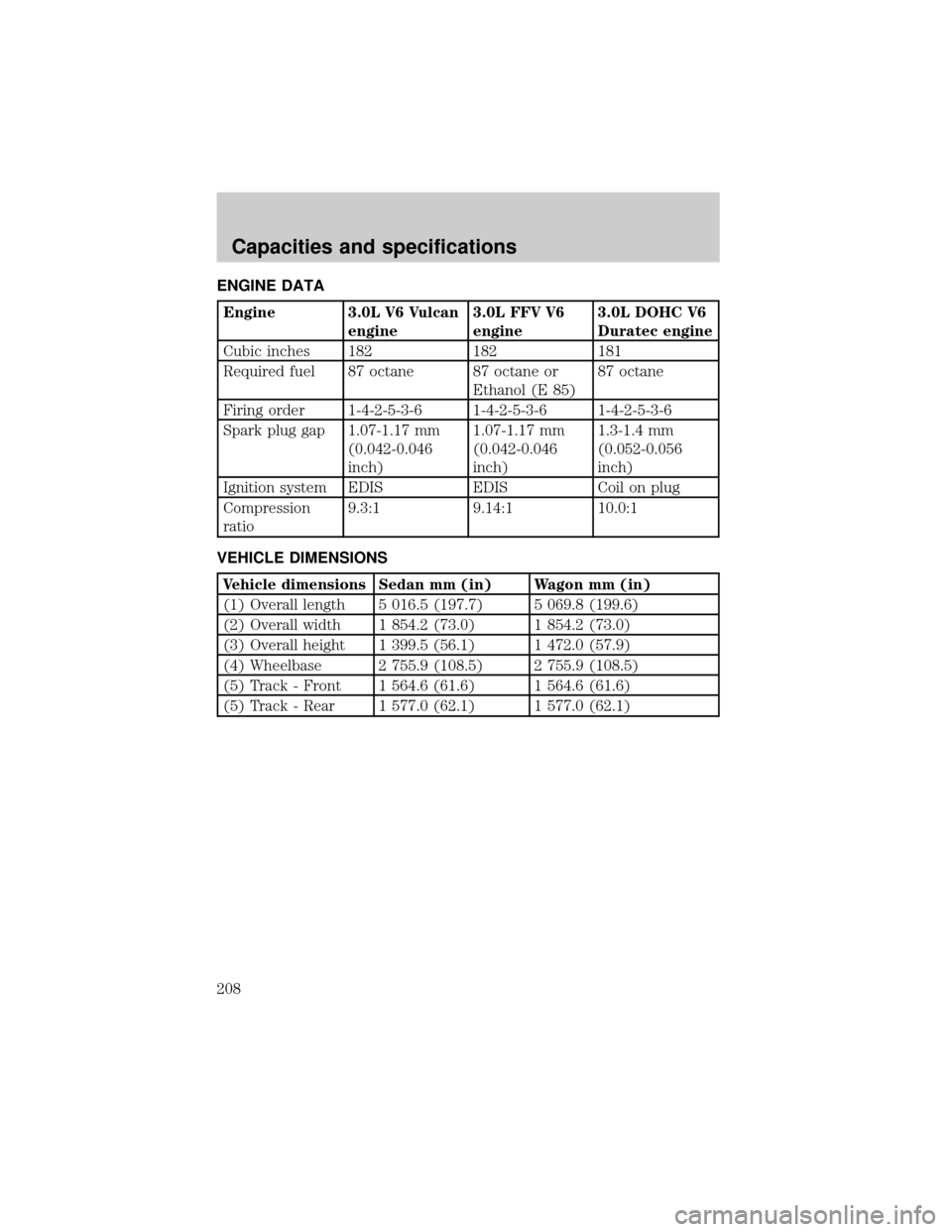
ENGINE DATA
Engine 3.0L V6 Vulcan
engine3.0L FFV V6
engine3.0L DOHC V6
Duratec engine
Cubic inches 182 182 181
Required fuel 87 octane 87 octane or
Ethanol (E 85)87 octane
Firing order 1-4-2-5-3-6 1-4-2-5-3-6 1-4-2-5-3-6
Spark plug gap 1.07-1.17 mm
(0.042-0.046
inch)1.07-1.17 mm
(0.042-0.046
inch)1.3-1.4 mm
(0.052-0.056
inch)
Ignition system EDIS EDIS Coil on plug
Compression
ratio9.3:1 9.14:1 10.0:1
VEHICLE DIMENSIONS
Vehicle dimensions Sedan mm (in) Wagon mm (in)
(1) Overall length 5 016.5 (197.7) 5 069.8 (199.6)
(2) Overall width 1 854.2 (73.0) 1 854.2 (73.0)
(3) Overall height 1 399.5 (56.1) 1 472.0 (57.9)
(4) Wheelbase 2 755.9 (108.5) 2 755.9 (108.5)
(5) Track - Front 1 564.6 (61.6) 1 564.6 (61.6)
(5) Track - Rear 1 577.0 (62.1) 1 577.0 (62.1)
Capacities and specifications
208
Page 227 of 232

low fuel warning light ..............10
octane rating ....................182,208
quality ......................................183
running out of fuel .................184
safety information relating to
automotive fuels .....................178
Fuses ...................................133,134
Gas cap (see Fuel cap) ............181
Gas mileage
(see Fuel economy) .................184
Gauges .........................................13
engine coolant
temperature gauge ...................14
fuel gauge ..................................15
odometer ...................................15
speedometer .............................13
tachometer ................................14
trip odometer ............................15
GAWR
(Gross Axle Weight Rating) .....123
definition .................................123
driving with a heavy load ......123
location ....................................123
GVWR (Gross
Vehicle Weight Rating) .............123
calculating ...............................123
definition .................................123
driving with a heavy load ......123
location ....................................123
Hazard flashers .........................131
Head restraints ...........................74
Headlamps ...................................16
aiming ......................................197
autolamp system .......................17
bulb specifications ..................196
daytime running lights .............16
flash to pass ..............................16
high beam ..............................8,16
replacing bulbs .......................190
turning on and off ....................16
warning chime ..........................13
Heating ........................................18heating and
air conditioning system ............18
Hood ..........................................149
Ignition ..................................43,208
Infant seats
(see Safety seats) .....................102
Inspection/
maintenance (I/M) testing .......189
Instrument panel
cleaning ...................................203
cluster ...................................8,203
lighting up
panel and interior .....................17
location of components ..............8
Jump-starting your vehicle ......142
Keyless entry system .................67
autolock .....................................69
keypad .......................................67
locking and unlocking doors ....68
programming entry code .........67
Keys
key in ignition chime ...............13
positions of the ignition ...........43
Lamps
autolamp system .......................17
bulb replacement
specifications chart ................196
cargo lamps ...............................17
daytime running light ...............16
headlamps .................................16
headlamps, flash to pass ..........16
instrument panel, dimming .....17
interior lamps ......................49,50
replacing
bulbs ............189,190,192,193,194
Lane change indicator
(see Turn signal) ........................47
Liftgate ...................................57,61
Lights, warning and indicator ......8
air bag ........................................12
anti-lock brakes (ABS) .....11,114
anti-theft ...................................11
Index
227
Page 228 of 232

brake ..........................................12
charging system ........................12
check coolant ............................11
cruise indicator .........................11
door ajar ......................................9
high beam ...................................8
low coolant ................................10
low fuel ......................................10
oil pressure ...............................12
safety belt ...................................9
service engine soon ....................9
speed control ............................46
traction control active ................8
turn signal indicator ...................8
Load limits .................................123
GAWR ......................................123
GVWR ......................................123
trailer towing ..........................123
Locks
autolock .....................................69
childproof ..................................54
Lubricant specifications ....207,208
Lumbar support, seats ...............76
Mirrors .........................................51
cleaning ...................................200
heated ........................................55
side view mirrors (power) .......55
Moon roof ....................................51
Motorcraft parts .................184,205
Octane rating ............................182
Odometer .....................................15
Oil (see Engine oil) ..................152
Overdrive ...................................119
Panic alarm feature, remote
entry system ................................61
Parking brake ............................115
Parts (see Motorcraft parts) ....205
Pedals (see Power adjustable
foot pedals) .................................43
Power adjustable foot pedals .....43
Power distribution box
(see Fuses) ...............................136Power door locks ........................54
Power steering ..........................117
fluid, checking and adding ....162
fluid, refill capacity ................206
fluid, specifications ..........207,208
Radio ............................................28
Relays .................................133,138
Remote entry system ............60,61
illuminated entry ......................62
locking/unlocking doors ......60,61
opening the trunk .....................61
panic alarm ...............................61
replacement/additional
transmitters ...............................62
replacing the batteries .............63
Roof rack ...................................129
Safety belts
(see Safety restraints) .....13,78,80
81,82,83,84,86
Safety defects, reporting ..........224
Safety restraints ......78,80,81,82,83
84,85,86,88
belt minder ...............................90
cleaning the safety belts ...93,203
extension assembly ..................89
for adults ....................81,82,83,84
for children ......................100,101
lap belt ......................................87
warning light and chime ..9,13,89
Safety seats for children ..........102
Seat belts
(see Safety restraints) ...............78
Seats ............................................74
child safety seats ....................102
cleaning ............................203,204
SecuriLock passive
anti-theft system ....................70,71
Servicing your vehicle ..............148
Spark plugs,
specifications ......................205,208
Specification chart,
lubricants ............................207,208
Index
228